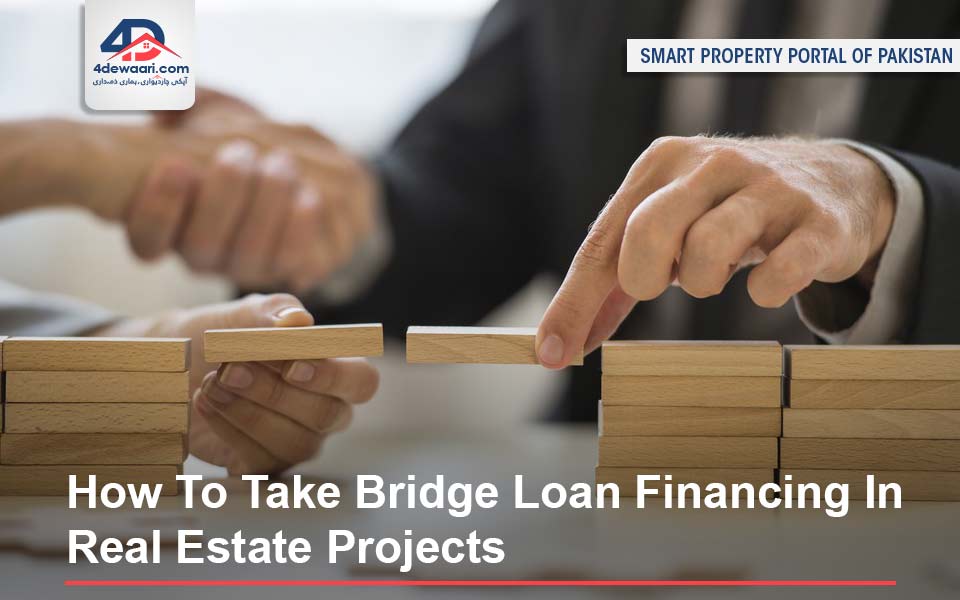A bridge loan can help you move into your dream home before selling your current home. Additionally, it can give you some flexibility when purchasing property on a timeline that doesn't align with your mortgage schedule. But if you aren't familiar with what they are and how they work, you might have questions about this funding option. Here's what you may want to know about bridge loans in real estate.
Bridge Loan In Real Estate
It is a temporary mortgage frequently used by borrowers who need funds to purchase houses. A bridge loan pays off the existing loan on the property and typically only lasts six months. The borrower makes monthly payments until they sell their old home or find a permanent solution. Unlike traditional mortgages, these loans are not based on credit scores. Let's say your current home has equity. In that case, you can use that as collateral for the bridge loan, which may provide more favourable terms than other lenders.
Read Also
Pakistan Real Estate Business
Bridge Loan Examples
For example, you may have $150,000 due on a loan. In that instance, you can obtain a bridge loan for 80% of the value of your present home. You then make the monthly payment on this new loan and any other expenses related to moving into your new place.
How Do Real Estate Bridge Loans Operate?
Suppose the profits from the sale of their present home haven't been received. In that case, people may find depositing their new property challenging. Homebuyers or investors borrow money from a lender with the current property as collateral to pay the expenses. The homebuyer can obtain a mortgage with this loan for six to twelve months. These loans are not provided by all financial institutions, though. As a result, you should do some investigations before visiting a lender. Additionally, the lenders typically don't extend the deadline, which puts prospective homeowners in danger. The lender may foreclose if the debtor fails to sell the current property within the allotted time. Therefore, developing a loan repayment strategy in advance with the lender is crucial.
Read Also
how to avoid common fraud in property
Bridge Loans In Commercial Real Estate
Commercial bridge loans are adaptable forms of short-term financing used to purchase commercial buildings and give extra money for property renovations. Commercial bridge loans frequently base their funding on the loan-to-cost (LTC) ratio or after-repair price, as opposed to permanent financing. Before granting or denying a proposal, lenders will consider a property's existing status, remodelling plans, and market situation.
Bridge Loan Requirements
Before you go through the process of getting a bridge loan, it's essential to know what's required for a good one. So, here are important details about bridge loans that you need to know before applying for this type of funding option.
- These funds can be used for any property transaction.
- They are typically offered as short-term financing, but there is no minimum length specified in most cases.
- A bridge loan often carries a heftier interest rate than other debts. The lender will look at risk factors such as how much equity your property has and how long the borrower plans to live in the home they're buying with their new loan.
- In addition, interest rates may change based on the project being funded. An investor might get better rates on an office building than a homeowner would get on a residential property.
- These funds are often provided by private lenders who lend out money based on their requirements.
- Lenders usually require that borrowers put down a sizable amount of their own money when applying for a bridge loan.
Pros And Cons Of Bridge Loan In Real Estate
PROS
- They can be a good option for borrowers with too little cash on hand for the down payment, closing costs, and other expenses of buying a home.
- Bridge loans are more straightforward to qualify for than many other forms of funding.
- It can be hard to find lenders willing to provide conventional financing when the borrower has less than 20% equity in their home. But, borrowers with as little as 5% down are eligible for bridge loans.
CONS
- The rate of return on this loan agreement is typically more significant than the standard conventional mortgage.
- Homebuyers frequently use bridge loans to buy a new property. If you cannot sell it promptly, you risk having two homes under your ownership. You will need to manage both properties simultaneously, which may be frustrating.
Substitutes For Bridge Loans
A bridge loan is an easy way to obtain money to buy a house before selling the one you currently live in. It isn't the only approach to creating funds, though. Other loan forms, such as a private, mortgage, and equity instalment loans, can offer long-term financing options for time-sensitive property transactions.
FAQs
How to Obtain a Bridge Loan for a Home Purchase?
You must fulfil specific requirements to be approved by a lender for a bridge loan. Before accepting the financing facility, the lender will consider your mortgage debt, payment history, family income, and loan ratio. In Pakistan, there are numerous banks offering mortgage loans.
How Long Does a Bridging Loan Take to Get?
Typically, banks will take 10-14 days to process your request. In some cases, they may also be likely to provide it the same day. However, suppose you need funding quickly and don't want to wait long. In that situation, there are still choices, like requesting a personal loan.
Final Thoughts
Bridge loans are an excellent way for real estate investors to secure additional project funding. You will, however, be required to pay excessive fees. So, as with any loan, it is essential that you have a clear understanding of the total cost of your financing and when you can expect your money back. Moreover, this could be the perfect solution if you want an investment property and need extra cash.















